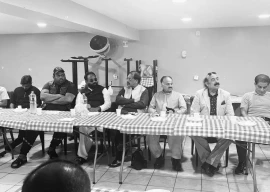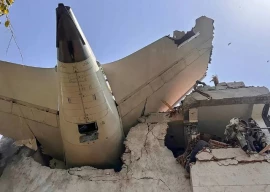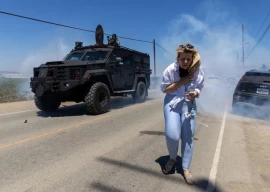
Police fired tear-gas and rubber bullets at the angry crowds as the workers, some armed with bamboo sticks, blockaded roads and attacked factories in the textile hub of Gazipur outside the Bangladeshi capital Dhaka.
"The situation is very volatile. Hundreds of thousands of workers have joined the protests," M Asaduzzaman of Gazipur police control room told AFP.
The violent scenes came as the death toll rose to 290 at the scene of the accident in Savar town on the outskirts of Dhaka where the eight-storey Rana Plaza factory bloc imploded on Wednesday morning.
The overnight rescue of 45 people provided some hope to the thousands of anguished relatives who remain huddled at the disaster site, but an intense stench of decomposition suggested many more bodies remain trapped in the rubble.
Widespread anger has been fuelled by revelations that factory bosses forced the 3,000-strong work force to return to the building on Wednesday despite cracks appearing in the building the day before.
It prompted new criticism of Western companies who were accused by activists of placing profit before safety by sourcing their products from the country despite its shocking track record of deadly disasters.
British low-cost fashion line Primark and Spanish giant Mango have acknowledged having their products made in the collapsed bloc, while a host of brands including Wal-Mart and France's Carrefour are investigating.
Italy's Benetton placed large orders with one of the suppliers, documents found by activists appear to show, but the group has denied having links to the building.
The United States said it could not confirm whether any US companies were sourcing garments from the complex, as protestors in San Francisco targeted the headquarters of Gap with banners reading "No More Death Traps".
"But it does underscore that there's a need for the government, owners, buyers and labour to find ways of improving working conditions in Bangladesh," deputy State Department spokesman Patrick Ventrell told reporters.
At the disaster scene, exhausted teams of soldiers, firemen and volunteers continued to work through the mountain of mangled concrete and steel for a third day after staying on the job for a second straight night.
Amid frustration about the slow pace of the efforts, thousands of anxious relatives burst onto the disaster site, prompting police to fire tear gas to disperse the crowd.
In the humid conditions, bodies trapped in the rubble were beginning to decay.
"The odour is so foul, sometimes you feel like vomiting. It's difficult to work here 20 minutes at a stretch," said Mohammad Tareq, a garment worker who is one of hundreds of volunteers.
While climbing on the upper reaches of the vast pile, Tareq said that one woman called Nasima had begged to be rescued from beneath the rubble and that she was with 15-20 other people.
"We've passed water and fruit juice to them. We hope they will be rescued in the next hours," Tareq told AFP.
National fire service chief Ahmed Ali told AFP that the rescuers were now "racing against time" to find survivors.
Police meanwhile made a series of raids to hunt down the factory and building owners after Prime Minister Sheikh Hasina vowed to track them down and bring them to justice.
"We're working to arrest them," Mukherjee told AFP.
Employees told how they were ordered to return to their production lines, where they earn as little as 37 dollars a month for long shifts six days a week, despite a police order closing the building.
Last November a blaze at a factory making products for Wal-Mart and other Western labels left 111 people dead, with survivors describing how fire exits were kept locked by site managers.


















COMMENTS
Comments are moderated and generally will be posted if they are on-topic and not abusive.
For more information, please see our Comments FAQ